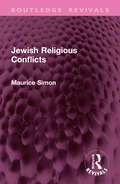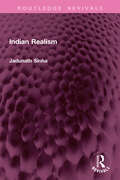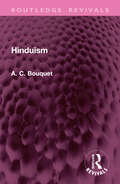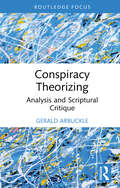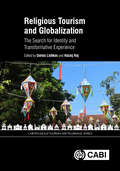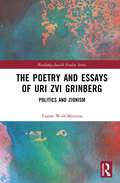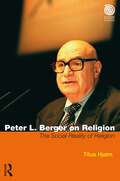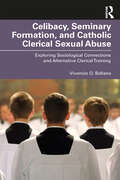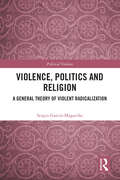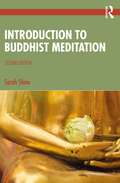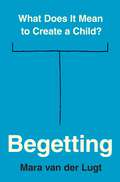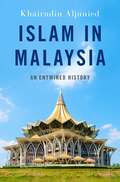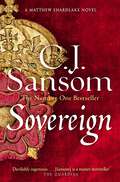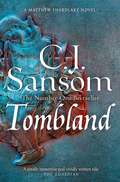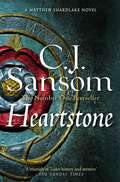- Table View
- List View
Jewish Religious Conflicts (Routledge Revivals)
by Maurice SimonFirst published in 1950, Jewish Religious Conflicts gives an account of the principal cleavages that have taken place within the Jewish people since the close of the Old Testament over questions of religious faith, doctrine and practice. While passing in review the chief sects that have formed themselves during that period, it pays particular attention to the most recent cleavages, those between the ‘orthodox’ and ‘reform’, and between the ‘conservative’ and ‘liberal’ movements, which are dividing the Jewish community. This book will be of interest to students of religion and history.
Jewish Religious Conflicts (Routledge Revivals)
by Maurice SimonFirst published in 1950, Jewish Religious Conflicts gives an account of the principal cleavages that have taken place within the Jewish people since the close of the Old Testament over questions of religious faith, doctrine and practice. While passing in review the chief sects that have formed themselves during that period, it pays particular attention to the most recent cleavages, those between the ‘orthodox’ and ‘reform’, and between the ‘conservative’ and ‘liberal’ movements, which are dividing the Jewish community. This book will be of interest to students of religion and history.
Indian Realism (Routledge Revivals)
by Jadunath SinhaFirst published in 1938, Indian Realism is a reconstruction of the Yogacara Vijnanavada (Subjective Idealism) and an exhaustive criticism of it by the different schools of Indian realism. The exposition of the doctrine is based on the works of Santaraksita and Kamalasila and the critics of Vijnanavada. Generally each thinker’s exposition and criticism have been given separately. Profound thinkers like Kumarila, Jayanta Bhatta, Vacaspatimisra, Sridhara and Sankara have been included. There is a criticism of Vedanta by the Buddhist realists and the different schools of the Vedanta. Incidentally, the Yogacara subjectivism has been compared with the idealism of Berkeley and the sensationism of Hume. Parallel arguments of many contemporary realists, too, have been quoted to show that philosophical genius of a particular type is apt to move in the same groove, irrespective of its location. This book will be of interest to students of philosophy, religion and South Asian studies.
Indian Realism (Routledge Revivals)
by Jadunath SinhaFirst published in 1938, Indian Realism is a reconstruction of the Yogacara Vijnanavada (Subjective Idealism) and an exhaustive criticism of it by the different schools of Indian realism. The exposition of the doctrine is based on the works of Santaraksita and Kamalasila and the critics of Vijnanavada. Generally each thinker’s exposition and criticism have been given separately. Profound thinkers like Kumarila, Jayanta Bhatta, Vacaspatimisra, Sridhara and Sankara have been included. There is a criticism of Vedanta by the Buddhist realists and the different schools of the Vedanta. Incidentally, the Yogacara subjectivism has been compared with the idealism of Berkeley and the sensationism of Hume. Parallel arguments of many contemporary realists, too, have been quoted to show that philosophical genius of a particular type is apt to move in the same groove, irrespective of its location. This book will be of interest to students of philosophy, religion and South Asian studies.
Hinduism (Routledge Revivals)
by A. C. BouquetFirst published in 1948, Hinduism presents an introductory outline of the story of Hinduism from the earliest times, and paves the way for further and more detailed study, as well as interests the general reader. It intends to exhibit Hinduism as an event rather than as something static; as an organism, developing, reforming itself, and even changing and absorbing new elements, rather than as a rigid creed, or even as a survival from the past. This book will be of interest to students of religion, history and South Asian studies.
Hinduism (Routledge Revivals)
by A. C. BouquetFirst published in 1948, Hinduism presents an introductory outline of the story of Hinduism from the earliest times, and paves the way for further and more detailed study, as well as interests the general reader. It intends to exhibit Hinduism as an event rather than as something static; as an organism, developing, reforming itself, and even changing and absorbing new elements, rather than as a rigid creed, or even as a survival from the past. This book will be of interest to students of religion, history and South Asian studies.
Conspiracy Theorizing: Analysis and Scriptural Critique (Routledge Focus on Religion)
by Gerald ArbuckleConspiracy Theorizing explore how should individuals with the Christian faith should react to conspiracy theories, their untruths, and their dangers. This book outlines the way that conspiracy theories are the fundamental basis for this stigmatization and scapegoating. It goes further to explain that scapegoating is fostering extreme divisions within in societies and between nations with each side often demonizing the other.This book states how conspiracy theories satisfy people’s needs for certainty, security, and a positive self-image in a world they feel is disintegrating. Uncovering deeper, when the comforting securities of cultures crumble, paranoia makes sense. This book demonstrates that an inability to live with uncertainty and ambiguity draws people to conspiracy theories when they validate their apprehensions. The commentary in this book also validates that since conspiracy theories can never be verified by objective research and truths they are one of the most problematic subjects to expose.This book aims to answer these questions: What are conspiracy theories? Why do they arise, especially in times of cultural upheavals? Are they harmful? What do the Christian Scriptures say about them? Readers that are interested in religion, Christianity and conspiracy theories would enjoy this book.
Conspiracy Theorizing: Analysis and Scriptural Critique (Routledge Focus on Religion)
by Gerald ArbuckleConspiracy Theorizing explore how should individuals with the Christian faith should react to conspiracy theories, their untruths, and their dangers. This book outlines the way that conspiracy theories are the fundamental basis for this stigmatization and scapegoating. It goes further to explain that scapegoating is fostering extreme divisions within in societies and between nations with each side often demonizing the other.This book states how conspiracy theories satisfy people’s needs for certainty, security, and a positive self-image in a world they feel is disintegrating. Uncovering deeper, when the comforting securities of cultures crumble, paranoia makes sense. This book demonstrates that an inability to live with uncertainty and ambiguity draws people to conspiracy theories when they validate their apprehensions. The commentary in this book also validates that since conspiracy theories can never be verified by objective research and truths they are one of the most problematic subjects to expose.This book aims to answer these questions: What are conspiracy theories? Why do they arise, especially in times of cultural upheavals? Are they harmful? What do the Christian Scriptures say about them? Readers that are interested in religion, Christianity and conspiracy theories would enjoy this book.
Religious Tourism and Globalization: The Search for Identity and Transformative Experience (CABI Religious Tourism and Pilgrimage Series)
by Vitor Ambrósio Silvia Aulet Serrallonga Caglar Bideci Mujde Bideci Elzbieta Bilska-Wodecka Dr Dino Bozonelos Dr Nour Farra-Haddad Stephen F. Haller Jaffer Idris Antonietta Ivona Isilda Leitão Dimitrios Mylonopoulos Polyxeni Moira Eleanor O’Keeffe Spyridon Parthenis Donatella Privitera Ricardo Nicolas Progano Alison T. SmithIs it possible to identify the positive and negative effects of globalization on religious tourism or to estimate the transformation of the internal and external constructs of pilgrimage by these effects? In order to address these questions, this book highlights the importance of the search for identity and transformative experience during religious tourism. It also looks at how, recently, globalization has played a part in the changes of the concept of personal and social identity and the transformative experience of pilgrimage. The chapters, consisting of carefully selected case studies, analyse possible effects including the adoption of different new rituals, new pilgrims' values, changes of tradition, acceptance of technologic innovations, development of new business models, and other environmental and sociocultural changes. The book provides: · a conceptual framework for understanding the impacts of globalization; · integrated cross-disciplinary approaches; and · an insight into major religious travel practices in the age of identity challenges and worldwide transformations. It will be suitable for researchers and students of religious tourism, pilgrimage, identity tourism, as well as related subjects such as sociology, anthropology, psychology, theology, history and cultural studies.
The Poetry and Essays of Uri Zvi Grinberg: Politics and Zionism (ISSN)
by Tamar Wolf-MonzonThis book focuses on the complex network of relationships between the poet Uri Zvi Grinberg and the Labor Movement in Mandate Palestine from 1923 to 1937.Making use of letters found in the Uri Zvi Grinberg Archive at the National Library of Israel (NLI), the author reconstructs the characteristics of Grinberg’s pioneer readership, attesting to their special relationship with his poetry. In the 1920s, it is argued, they considered Grinberg’s poetry an authentic expression of their complex spiritual world and especially of the reality of their lives. On his side, Grinberg accepted the pioneering ethos as the ideological basis of his works, becoming an outstanding poet of the Labor Movement. The chapters of this book track the various phases of Grinberg’s life and poetry, from his emigration to Palestine through to the 1930s, when he joined the Revisionist Movement and became increasingly ostracized from the Labor Movement. The story of Grinberg’s relations with the pioneers was emotionally charged—a mixture of enchantment and rejection, spiritual closeness and repulsion. Ultimately, this book analyzes the intensity of this connection and its many contradictory layers.This book will interest researchers in a range of fields, including Hebrew poetry and reception theory, as well as anyone interested in Israeli studies and the history of the Labor Movement in Palestine.
The Poetry and Essays of Uri Zvi Grinberg: Politics and Zionism (ISSN)
by Tamar Wolf-MonzonThis book focuses on the complex network of relationships between the poet Uri Zvi Grinberg and the Labor Movement in Mandate Palestine from 1923 to 1937.Making use of letters found in the Uri Zvi Grinberg Archive at the National Library of Israel (NLI), the author reconstructs the characteristics of Grinberg’s pioneer readership, attesting to their special relationship with his poetry. In the 1920s, it is argued, they considered Grinberg’s poetry an authentic expression of their complex spiritual world and especially of the reality of their lives. On his side, Grinberg accepted the pioneering ethos as the ideological basis of his works, becoming an outstanding poet of the Labor Movement. The chapters of this book track the various phases of Grinberg’s life and poetry, from his emigration to Palestine through to the 1930s, when he joined the Revisionist Movement and became increasingly ostracized from the Labor Movement. The story of Grinberg’s relations with the pioneers was emotionally charged—a mixture of enchantment and rejection, spiritual closeness and repulsion. Ultimately, this book analyzes the intensity of this connection and its many contradictory layers.This book will interest researchers in a range of fields, including Hebrew poetry and reception theory, as well as anyone interested in Israeli studies and the history of the Labor Movement in Palestine.
Peter L. Berger on Religion: The Social Reality of Religion (Key Thinkers in the Study of Religion)
by Titus HjelmPeter L. Berger on Religion provides an overview and critical assessment of the work of one of the most influential sociologists of the 20th century.Situating Berger’s writings on religion and secularisation in the broader framework of social constructionism, the book argues that neither he nor the research influenced by him consistently followed the constructionist paradigm. This assessment is informed by a close examination of The Sacred Canopy (1967), in particular. The volume also offers a Berger‑inspired constructionist framework for the study of religion.This book is an excellent resource for students and researchers interested in the intersection of religion and social theory.
Peter L. Berger on Religion: The Social Reality of Religion (Key Thinkers in the Study of Religion)
by Titus HjelmPeter L. Berger on Religion provides an overview and critical assessment of the work of one of the most influential sociologists of the 20th century.Situating Berger’s writings on religion and secularisation in the broader framework of social constructionism, the book argues that neither he nor the research influenced by him consistently followed the constructionist paradigm. This assessment is informed by a close examination of The Sacred Canopy (1967), in particular. The volume also offers a Berger‑inspired constructionist framework for the study of religion.This book is an excellent resource for students and researchers interested in the intersection of religion and social theory.
Celibacy, Seminary Formation, and Catholic Clerical Sexual Abuse: Exploring Sociological Connections and Alternative Clerical Training (Routledge Studies in the Sociology of Religion)
by Vivencio O. BallanoDoes the current celibate, semi-monastic, and all-male seminary formation contribute to the persistence of clerical sexual abuse in the Roman Catholic Church?Applying sociological theories on socialization, total institutions, and social resistance as the primary conceptual framework, and drawing on secondary literature, media reports, the author’s experience, interviews, and Church documents, this book argues that the Catholic Church’s institution of the celibate seminary formation as the only mode of clerical training for Catholic priests has resulted in negative unintended consequences to human formation such as the suspension of normal human socialization in society, psychosexual immaturity, and weak social control against clerical sexual abuse. The author thus contends that celibate training, while suitable for those who do live in religious or monastic communities, is inappropriate for those who are obliged to live alone and work in parishes. As such, an alternative model for diocesan clerical formation is advanced.A fresh look at the aptness – and effects – of celibate formation for diocesan clergy, this volume is the first to relate the persistence of Catholic clerical sexual abuse to celibate seminary formation, exploring the structural links between the two using sociological arguments and proposing an apprenticeship-based model of formation, which has numerous advantages as a form of clerical training. It will therefore appeal to scholars and students of religion, sociology, and theology, as well as those involved with seminary formation.
Celibacy, Seminary Formation, and Catholic Clerical Sexual Abuse: Exploring Sociological Connections and Alternative Clerical Training (Routledge Studies in the Sociology of Religion)
by Vivencio O. BallanoDoes the current celibate, semi-monastic, and all-male seminary formation contribute to the persistence of clerical sexual abuse in the Roman Catholic Church?Applying sociological theories on socialization, total institutions, and social resistance as the primary conceptual framework, and drawing on secondary literature, media reports, the author’s experience, interviews, and Church documents, this book argues that the Catholic Church’s institution of the celibate seminary formation as the only mode of clerical training for Catholic priests has resulted in negative unintended consequences to human formation such as the suspension of normal human socialization in society, psychosexual immaturity, and weak social control against clerical sexual abuse. The author thus contends that celibate training, while suitable for those who do live in religious or monastic communities, is inappropriate for those who are obliged to live alone and work in parishes. As such, an alternative model for diocesan clerical formation is advanced.A fresh look at the aptness – and effects – of celibate formation for diocesan clergy, this volume is the first to relate the persistence of Catholic clerical sexual abuse to celibate seminary formation, exploring the structural links between the two using sociological arguments and proposing an apprenticeship-based model of formation, which has numerous advantages as a form of clerical training. It will therefore appeal to scholars and students of religion, sociology, and theology, as well as those involved with seminary formation.
Violence, Politics and Religion: A General Theory of Violent Radicalization (ISSN)
by Sergio García-MagariñoThis book offers a general theory of violent radicalization and uses case studies from a variety of different countries and groups to illustrate this.The first and fundamental objective of the book is to provide an explanatory framework to understand phenomena related to violent radicalization, deradicalization, the prevention of radicalization and to political violence; in particular, that inspired by religion. The second objective follows from the first. Understanding violent radicalization of religious inspiration implies delving into two key concepts: violent radicalization and religion. This second objective is indeed elusive, since, on the one hand, many liberal democracies have undergone processes of secularization or, at least, have lost interest in examining religion in public debates. Therefore, rigorously exploring social problems where religion seems to be involved, in one way or another, is complicated. Moreover, the notion of violent radicalization, in turn, is highly contested and confused with other ideas, such as polarization, extremism, terrorism or nonviolent radicalization. Finally, the book aims to bring theory into dialogue with empirical phenomena, and to test it against concrete cases related to violent radicalization and its prevention, on the one hand, and religion, on the other. The book’s originality comes from both its innovative, methodological approach and its breadth, with cases from several countries (Spain, the United States, Ireland, India, Israel, Russia and Colombia) and different ideological groups (revolutionary communists, nationalist movements, Jihadist groups, white and black supremacists).This book will be of much interest to students of terrorism and political violence, radicalization, sociology and international relations in general.
Violence, Politics and Religion: A General Theory of Violent Radicalization (ISSN)
by Sergio García-MagariñoThis book offers a general theory of violent radicalization and uses case studies from a variety of different countries and groups to illustrate this.The first and fundamental objective of the book is to provide an explanatory framework to understand phenomena related to violent radicalization, deradicalization, the prevention of radicalization and to political violence; in particular, that inspired by religion. The second objective follows from the first. Understanding violent radicalization of religious inspiration implies delving into two key concepts: violent radicalization and religion. This second objective is indeed elusive, since, on the one hand, many liberal democracies have undergone processes of secularization or, at least, have lost interest in examining religion in public debates. Therefore, rigorously exploring social problems where religion seems to be involved, in one way or another, is complicated. Moreover, the notion of violent radicalization, in turn, is highly contested and confused with other ideas, such as polarization, extremism, terrorism or nonviolent radicalization. Finally, the book aims to bring theory into dialogue with empirical phenomena, and to test it against concrete cases related to violent radicalization and its prevention, on the one hand, and religion, on the other. The book’s originality comes from both its innovative, methodological approach and its breadth, with cases from several countries (Spain, the United States, Ireland, India, Israel, Russia and Colombia) and different ideological groups (revolutionary communists, nationalist movements, Jihadist groups, white and black supremacists).This book will be of much interest to students of terrorism and political violence, radicalization, sociology and international relations in general.
Introduction to Buddhist Meditation
by Sarah ShawThis lively introduction to Buddhist meditation offers students and practitioners alike a deeper understanding of what meditation is and its purpose and place in the context of different Buddhist schools. The historical background and geographical spread of Buddhist meditation is explored alongside an examination of the development of meditative practices. Chapters cover basic meditative practice, types of meditation, meditation in different regions, meditation and doctrine, and the role of chanting within meditation. Although not a practical guide, Introduction to Buddhist Meditation outlines the procedures associated with Buddhist practices and suggests appropriate activities, useful both for students and interested Buddhists. Vivid quotations from Buddhist texts and carefully selected photographs and diagrams help the reader engage fully with this fascinating subject.Thoroughly revised throughout, this new edition also features a glossary and key, making it ideal reading for students approaching the topic of Buddhist meditation for the first time.
Introduction to Buddhist Meditation
by Sarah ShawThis lively introduction to Buddhist meditation offers students and practitioners alike a deeper understanding of what meditation is and its purpose and place in the context of different Buddhist schools. The historical background and geographical spread of Buddhist meditation is explored alongside an examination of the development of meditative practices. Chapters cover basic meditative practice, types of meditation, meditation in different regions, meditation and doctrine, and the role of chanting within meditation. Although not a practical guide, Introduction to Buddhist Meditation outlines the procedures associated with Buddhist practices and suggests appropriate activities, useful both for students and interested Buddhists. Vivid quotations from Buddhist texts and carefully selected photographs and diagrams help the reader engage fully with this fascinating subject.Thoroughly revised throughout, this new edition also features a glossary and key, making it ideal reading for students approaching the topic of Buddhist meditation for the first time.
Begetting: What Does It Mean to Create a Child?
by Mara van der LugtAn investigation of what it means to have children—morally, philosophically and emotionally&“Do you want to have children?&” is a question we routinely ask each other. But what does it mean to create a child? Is this decision always justified? Does anyone really have the moral right to create another person? In Begetting, Mara van der Lugt attempts to fill in the moral background of procreation. Drawing on both philosophy and popular culture, van der Lugt does not provide a definitive answer on the morality of having a child; instead, she helps us find the right questions to ask.Most of the time, when we talk about whether to have children, what we are really talking about is whether we want to have children. Van der Lugt shows why this is not enough. To consider having children, she argues, is to interrogate our own responsibility and commitments, morally and philosophically and also personally. What does it mean to bring a new creature into the world, to decide to perform an act of creation? What does it mean to make the decision that life is worth living on behalf of a person who cannot be consulted? These questions are part of a conversation we should have started long ago. Van der Lugt does not ignore the problematic aspects of procreation—ethical, environmental and otherwise. But she also acknowledges the depth and complexity of the intensely human desire to have a child of our own blood and our own making.
Begetting: What Does It Mean to Create a Child?
by Mara van der LugtAn investigation of what it means to have children—morally, philosophically and emotionally&“Do you want to have children?&” is a question we routinely ask each other. But what does it mean to create a child? Is this decision always justified? Does anyone really have the moral right to create another person? In Begetting, Mara van der Lugt attempts to fill in the moral background of procreation. Drawing on both philosophy and popular culture, van der Lugt does not provide a definitive answer on the morality of having a child; instead, she helps us find the right questions to ask.Most of the time, when we talk about whether to have children, what we are really talking about is whether we want to have children. Van der Lugt shows why this is not enough. To consider having children, she argues, is to interrogate our own responsibility and commitments, morally and philosophically and also personally. What does it mean to bring a new creature into the world, to decide to perform an act of creation? What does it mean to make the decision that life is worth living on behalf of a person who cannot be consulted? These questions are part of a conversation we should have started long ago. Van der Lugt does not ignore the problematic aspects of procreation—ethical, environmental and otherwise. But she also acknowledges the depth and complexity of the intensely human desire to have a child of our own blood and our own making.
Islam in Malaysia: An Entwined History (Religion and Global Politics)
by Khairudin AljuniedThis book surveys the growth and development of Islam in Malaysia from the eleventh to the twenty-first century, investigating how Islam has shaped the social lives, languages, cultures and politics of both Muslims and non-Muslims in one of the most populous Muslim regions in the world. Khairudin Aljunied shows how Muslims in Malaysia built upon the legacy of their pre-Islamic past while benefiting from Islamic ideas, values, and networks to found flourishing states and societies that have played an influential role in a globalizing world. He examines the movement of ideas, peoples, goods, technologies, arts, and cultures across into and out of Malaysia over the centuries. Interactions between Muslims and the local Malay population began as early as the eighth century, sustained by trade and the agency of Sufi as well as Arab, Indian, Persian, and Chinese scholars and missionaries. Aljunied looks at how Malay states and societies survived under colonial regimes that heightened racial and religious divisions, and how Muslims responded through violence as well as reformist movements. Although there have been tensions and skirmishes between Muslims and non-Muslims in Malaysia, they have learned in the main to co-exist harmoniously, creating a society comprising of a variety of distinct populations. This is the first book to provide a seamless account of the millennium-old venture of Islam in Malaysia.
Sovereign: A Matthew Shardlake Mystery (The Shardlake series #3)
by C. J. Sansom'C. J. Sansom’s books are arguably the best Tudor novels going' – The Sunday TimesFollowing on from Dissolution and Dark Fire, Sovereign is the third gripping historical novel in C. J. Sansom's number one bestselling Shardlake series, perfect for fans of Hilary Mantel and Philippa Gregory.England, 1541. King Henry VIII has set out on a spectacular Progress to the North to attend an extravagant submission by his rebellious subjects in York.Already in the city are lawyer Matthew Shardlake and his assistant Jack Barak, whom have reluctantly undertaken a special mission for Archbishop Thomas Cranmer – to ensure the welfare of an important but dangerous conspirator who is to be returned to London for interrogation.But the murder of a York glazier involves Shardlake in deeper mysteries, connected not only to the prisoner in York castle but to the royal family itself. And when Shardlake and Barak stumble upon a cache of secret documents which could threaten the Tudor throne, a chain of events unfolds that will lead Shardlake to face the most terrifying fate of the age . . .This is the third novel in C. J. Sansom's internationally bestselling Shardlake series. It is followed by Revelation, the fourth book in the series.
Tombland (The Shardlake series #7)
by C. J. Sansom'C. J. Sansom’s books are arguably the best Tudor novels going' – The Sunday TimesTombland is the seventh epic novel in C. J. Sansom's number one bestselling Shardlake series, perfect for fans of Hilary Mantel and Philippa Gregory.England, 1549. Two years after the death of Henry VIII, England is sliding into chaos. The economy is in collapse, inflation rages and rebellion is stirring among the peasantry . . .Since the old king’s death, Matthew Shardlake has been working as a lawyer in the service of Henry’s daughter, the Lady Elizabeth. The gruesome murder of Edith Boleyn – a distant relative in Norfolk – sends Shardlake and his assistant Nicholas Overton to the summer Assizes at Norwich. And then East Anglia explodes, as peasant rebellion breaks out across the country. The yeoman Robert Kett leads a force of thousands in overthrowing the landlords and taking over Norwich, England’s second largest city.Now Shardlake must decide where his ultimate loyalties lie, as government forces in London prepare to march north and destroy the rebels. Meanwhile he discovers that the murder of Edith Boleyn may have connections reaching into both the heart of the Norfolk gentry and the rebel camp itself . . .This is the seventh novel in C. J. Sansom's thrilling historical series that started with Dissolution. Includes an Historical Essay from the author on Reimagining Kett's Rebellion.
Heartstone: Murder Mystery and Tudor History in This Atmospheric Historical Fiction Novel (The Shardlake series #5)
by C. J. Sansom'C. J. Sansom’s books are arguably the best Tudor novels going' – The Sunday TimesHeartstone is the fifth spellbinding mystery in C. J. Sansom’s number one bestselling Shardlake series, perfect for fans of Hilary Mantel and Philippa Gregory.England, 1545. England is at war. Henry VIII’s invasion of France has gone badly wrong, and a massive French fleet is preparing to sail across the Channel.Meanwhile, Matthew Shardlake is given an intriguing legal case by an old servant of Queen Catherine Parr. Asked to investigate claims of ‘monstrous wrongs’ committed against a young ward of the court, Shardlake and his assistant Jack Barak journey to Portsmouth. There, Shardlake also intends to investigate the mysterious past of Ellen Fettiplace, a young woman incarcerated in the Bedlam.Once in Portsmouth, Shardlake and Barak find themselves in a city preparing for war. The mysteries surrounding the two cases involve Shardlake in reunions both with an old friend and an old enemy close to the throne. And soon, events will converge on board one of the King’s great warships gathered in Portsmouth harbour, waiting to confront the approaching French fleet . . .Heartstone is the fifth novel in C. J. Sansom's gripping historical series. It is followed by the sixth book in the series, Lamentation.
